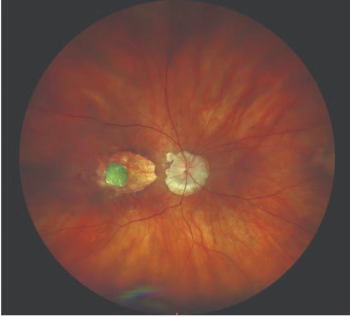
Pre-existing ruptured posterior capsule presents unique challenges
Surgeons are urged to take a more cautious approach to cataract surgery when a new, pre-existing rupture of the posterior capsule surfaces.
Surgeons are urged to take a more cautious approach to cataract surgery when a new, pre-existing rupture of the posterior capsule surfaces.
For example, it is important to gently remove the nuclear material first while the cortex is still in place, said Gregory S.H. Ogawa, MD. The cortex can act as a scaffold, or splint, to help maintain support posteriorly.
Dr. Ogawa, cornea and complex anterior segment specialist, Eye Associates of New Mexico, and assistant clinical professor of ophthalmology, University of New Mexico, Albuquerque, described the challenges associated with such a case.
A retina specialist was treating a 56-year-old patient for a vitreous hemorrhage. After performing a pars plana vitrectomy and peeling scar tissue on the retina, the specialist prepared to cauterize a bleeding vessel. At that moment, the patient turned his head, causing the cautery probe to pierce the nasal portion of the lens. A cataract rapidly ensued, obscuring the view of the posterior segment.
While some situations involving a posterior capsule rupture can be addressed weeks or months while the capsule begins to fibrose and to be less prone to splitting, the retina specialist in this case wanted to promptly view the posterior segment so cataract surgery could not be delayed.
To watch Dr. Ogawa perform this procedure, click
Day 1 post-op exam
Dr. Ogawa examined the patient the next day. He found a dense posterior subcapsular cataract across the nasal two-thirds of the posterior portion of the lens, with a white feathery pattern. A linear track from the cautery probe was visible from near the center of the posterior portion of the lens tracking inferonasally.
Both the patient’s eyes had histories of retinal tears and 12 years earlier, he had LASIK treatments. However, the main issue was the split in the posterior capsule.
The following day-two days after the pars plana vitrectomy-Dr. Ogawa operated to remove the cataract and implant an IOL.
“The whole surgery was done gently, trying to lift the cataract material up and out as opposed to standard phacoemulsification with pressure down on the lens while it is removed,” Dr. Ogawa said. “If I had done a regular cataract procedure, it is very likely that all the nuclear material would have dropped to the back of the vitrectomized eye.”
Dr. Ogawa proceeded with a scleral tunnel incision, which can be enlarged without inducing a lot of post-operative astigmatism.
“If it had been needed, I could make a larger incision that could still be stable after the surgery, yet be large enough to be able to take out bigger pieces of lens material,” Dr. Ogawa explained. “In this particular case, I was able to aspirate all the lens material. If it was a denser nucleus, I would have needed to remove it manually through a larger incision, or through a small incision using an extremely gentle phacoemulsification technique.”
Dr. Ogawa used a low-flow set-up with a limbal infusion cannula and a manual cortex aspirator (his own invention), along with an IOL manipulator to physically lift the nucleus anteriorly after a careful hydrodelineation around the nucleus. After removal of the nucleus, he removed the cortex from the periphery prior to removing central cortex to minimize how much lens material might go posteriorly when the capsule no longer had support and split open further.
Dr. Ogawa kept the bottle height at about 30 cm in contrast to the 70 or 105 cm height typical for phacoemulsification cataract surgery. “With doing things this way, I could do everything more slowly and be able to lift material anteriorly in a more controlled fashion,” he added.
Video Courtesy of Gregory S.H. Ogawa, MD
No hydrodissection
Dr. Ogawa did not use hydrodissection, which would have sent the fluid behind the lens, creating pressure on the ruptured posterior capsule with the chance of splitting it wide open with posterior loss of the cataract. Instead, he used only hydrodelineation, injecting fluid between cortex and nucleus to make it easier to remove the nucleus while the cortex stayed in place.
The traction on the central capsule during removal of the last cortical pieces triggered a complete split of the posterior capsule, allowing a small piece of cortex to drop to the posterior pole.
Dr. Ogawa used a flat surface Machamer-style irrigating contact lens to inspect the posterior segment. With the lens for visualization, he was able to remove the lens material with a vitrectomy probe through a limbal paracentesis.
Finally, he implanted a STAAR AQ2010V IOL (STAAR Surgical) in the sulcus. “This lens has a 13.5-mm overall diameter, so it is big enough to be relatively stable in the sulcus,” he explained.
Dr. Ogawa selected a silicon lens with small, round haptics and rounded optic edges because acrylic lenses with squared edges on the optic and haptics can rub on the iris, causing pigment dispersion, inflammation, and IOP elevation.
Upon follow-up a year after the procedure, the patient’s vision was 20/40 uncorrected in this eye, and with minimal refractive correction, the vision was 20/25.
Gregory S.H. Ogawa, MD
e: gogawa@eyenm.com
This article is adapted from Dr. Ogawa’s presentation at the 2015 American Society of Cataract and Refractive Surgery meeting.
Newsletter
Keep your retina practice on the forefront—subscribe for expert analysis and emerging trends in retinal disease management.












































